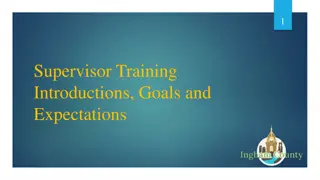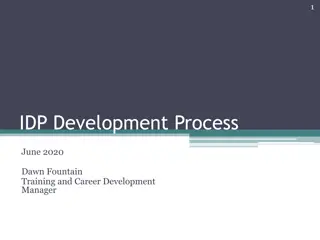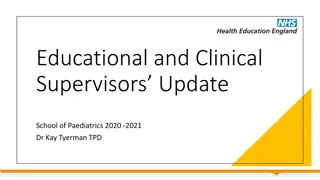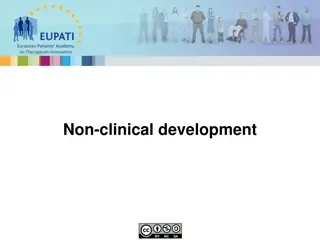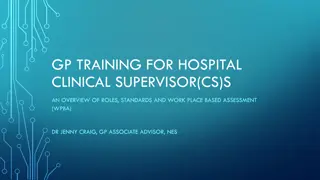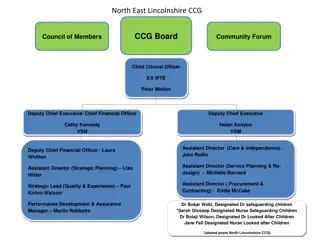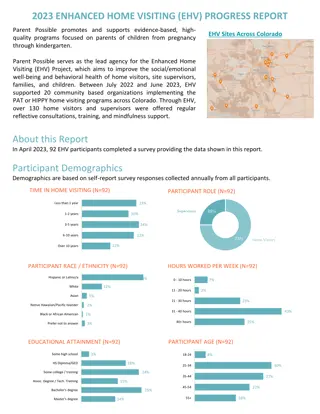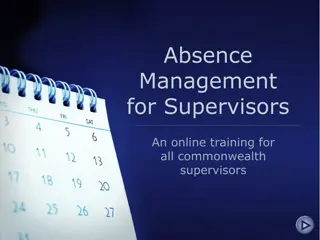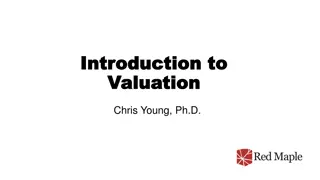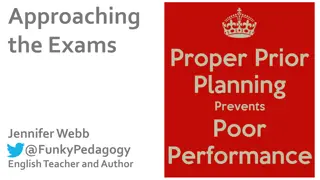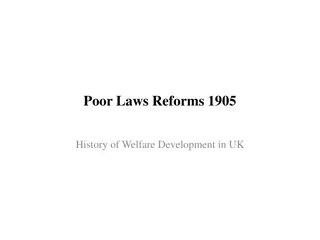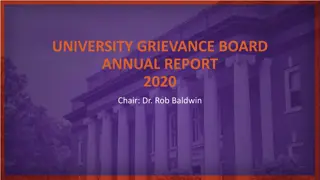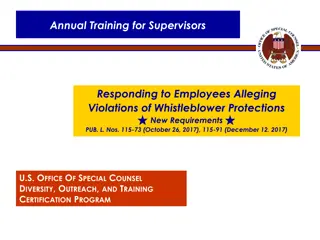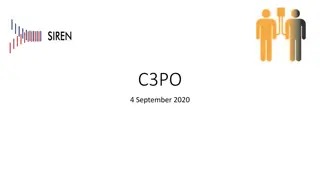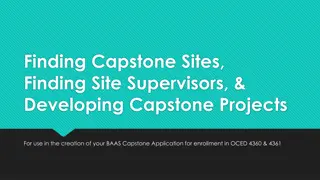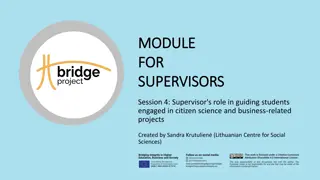Dr. Chris Webb's December 2020 Clinical Supervisors Report
A structured Clinical Supervisors Report (CSR) for Dr. Chris Webb in December 2020. This report provides insight into the clinical supervision process within various posts and includes valuable information from the Clinical Supervisor.
Download Presentation

Please find below an Image/Link to download the presentation.
The content on the website is provided AS IS for your information and personal use only. It may not be sold, licensed, or shared on other websites without obtaining consent from the author.If you encounter any issues during the download, it is possible that the publisher has removed the file from their server.
You are allowed to download the files provided on this website for personal or commercial use, subject to the condition that they are used lawfully. All files are the property of their respective owners.
The content on the website is provided AS IS for your information and personal use only. It may not be sold, licensed, or shared on other websites without obtaining consent from the author.
E N D
Presentation Transcript
Clinical Supervisors Report CSR Dr Chris Webb - December 2020
Clinical Supervisors Report (CSR) The Clinical Supervisors Report (CSR) is a short, structured report completed by the Clinical Supervisor in each post It is essential this is done towards the end of the trainee s non-primary care posts and also in primary care posts if any of the following apply: The Clinical Supervisor in practice is a different person to the Educational Supervisor The evidence in the Portfolio does not give a full enough picture of their progress in training and information in a CSR would provide this missing information Either the trainee or their supervisor feels it is appropriate
Clinical Supervisors Report ...Continued The CSR is an opportunity for the trainee to receive feedback about their performance and the conversation with the CS that accompanies it can be particularly useful A well completed CSR is also a valuable source of evidence for each Capability in the Educational Supervisor Review and for ARCP panels The new CSR has been rewritten to: Make a clear link between each section and the relevant GP Capabilities Ensure that all the GP Capabilities are covered in the report Introduce an overall assessment by the Clinical Supervisor (CS) of the level of supervision that you have required Make the report shorter and easier for busy clinicians to complete
Who carries out the CSR? The Clinical Supervisor is responsible for writing the report although it is appropriate and usual for the CS to discuss the CSR with colleagues to inform the final report In addition to this gathering of information from colleagues it is expected that the CS will have carried out at least one of the mandatory Workplace Based Assessments personally (CBD/MiniCEX/COT) prior to each CSR Where there are particular concerns about the trainee s progress and there is more than one experienced CS working in the department or practice, it is appropriate, and good practice, for there to be more than one CSR written for a single period of training It is the trainees responsibility to arrange a meeting with their CS to ensure the report is completed before the end of their placement and in time for their ESR meeting
What is the reference point? Because the CSR is used in both primary care and non-primary care, it is important that the reference point is one that will be recognised in both settings Two versions of the CSR have been written - one for non-primary care posts and a second version for primary care posts The Clinical Supervisor in a non-primary care CSR is asked to make a comparison of the trainee s performance with the expected performance of a GP trainee at that level of experience in that post. The assessment form, therefore, asks the CS to make a judgement (after recording their comments) of whether they are: Significantly Below Expectations Below Expectations Meets Expectations Above Expectations
What is the reference point? ...Continued The Clinical Supervisor in a primary care post is asked to make a comparison of the trainee s performance with the standard expected of a trainee at the end of ST3 (a newly qualified independent GP) The grades match those in the ESR and the form asks the CS to make a judgement of whether they are: Needing Further Development - Below Expectations Needing Further Development - Meeting Expectations Competent Excellent
What does the form review? Each of the seven questions covers a particular area of practice, for example Professionalism There follows a description of how this is likely to be observed in the working environment Professionalism, for example, includes being respectful, diligent and self-directed in your approach to patients and others and to your own learning needs, developing resilience and making appropriate ethical decisions Each question will automatically be linked to specific Capabilities in the Portfolio (e.g. Maintaining Performance Learning and Teaching, Ethics, Fitness to practice)
What does the form review? ...Continued Word descriptors (see later) have been written to support the grading and feedback for each question The CS is also asked to make an assessment of the level of supervision required compared to the expected level of performance for a GP trainee at this stage (see later) There are 4 levels of supervision and if more supervision than would be expected is required, or you cannot be left without supervision, then an additional comment box will appear asking for further details Finally, in line with all other specialties there is a question about whether the trainee has been involved in conduct, capability or Significant Events and what the outcome has been
Short posts (3/12 or less) It is particularly important that a CSR is completed the trainee has been in a short post so that there is an assessment of engagement and learning in the post (It would also be expected that there should be pro rata assessments (CBD/ MiniCEX/ COT) for these posts)
Being both ES and CS There are occasions when the same person will be the trainee s Clinical Supervisor and Educational Supervisor. The CSR is a summary of the observations of the supervisor (whether or not they are also an ES) on their performance under the various Capability headings. It is an opinion based on observation, debriefing, tutorials, etc. The ESR, in contrast, is a summary of the information from different sources of your performance, recorded in your Portfolio. It is appropriate for the ES to quote as evidence along with other evidence the assessment made by the CS (even if the ES also completed the CSR) If the CS is also the ES in a primary care post then the CSR does not need to be completed unless the evidence within the Portfolio does not give a full enough picture and information in a CSR would provide this missing information, or the trainee and their supervisor feel it is appropriate. In these situations, the CSR should be completed irrespective of whether the CS and ES are the same person
Communication between the ES and CS The CSR is one of several sources of evidence used by the ES to reach a judgement about the trainees progress While it has been designed to provide useful structured information, it is no substitute for dialogue between the Clinical and Educational Supervisor If there are known concerns about performance prior to the start of a post it is appropriate for the ES and/or the Training Programme Director to ensure that the CS is aware of the concerns and for the ES to remain available for advice. It is good practice for the trainee also to be aware of these conversations and their overall content
Level Supervision definition Cannot be left without direct supervision Limited to observing care; and / or Seeing patients alone but not allowed to let patients leave the building or complete an episode of care before review by the supervisor 1* Requires more supervision than expected in their clinical role Requires direct supervision by named supervisor: The trainee may provide clinical care, but the supervisor, (in their absence delegated supervisor), is physically within the building and is immediately available if required to provide direct supervision on specific cases and non - immediate review of all cases 2* Requires expected levels of supervision in their clinical role Requires indirect supervision by the named supervisor: The trainee may provide clinical care when the supervisor is at a distance (urgent /unscheduled care, home visits) but is available by means of telephone to provide advice, and available to attend jointly if required to provide direct supervision. The trainee does not need to have every case reviewed but a regular review of random or selected cases takes place at routine intervals 3 Requires no supervision in their clinical role It is proposed that GP trainees will only reach Level 4 at the end of their training 4 (ST3 only) *If levels 1 or 2 are selected the Clinical Supervisor will be required to clarify their reasons for this choice and it is expected that they would then also contact their local GP Associate Dean/Training Programme Director and/or Educational Supervisor to inform them of their concerns
Fitness to practise This is about professionalism and the actions expected to protect people from harm. This includes the awareness of when an individual s performance, conduct or health, or that of others, might put patients, themselves or their colleagues at risk Indicators of Potential Underperformance Needs Further Development Competent Excellent Demonstrates the accepted codes of practice in order to promote patient safety and effective team working Encourages scrutiny of professional behaviour, is open to feedback and demonstrates a willingness to change Fails to respect the requirements of the organisation e.g. meeting deadlines, producing documentation, observing contractual obligations Has repeated unexplained or unplanned absences from professional commitments Prioritises his/her own interests above those of the patient Fails to cope adequately with pressure e.g. dealing with stress or managing time Is the subject of multiple complaints Fails to respect the requirements of the organisation e.g. meeting deadlines, producing documentation, observing contractual obligations Has repeated unexplained or unplanned absences from professional commitments Prioritises his/her own interests above those of the patient Understands the GMC document, Duties of a Doctor Achieves a balance between their professional and personal demands that meets their work commitments and maintains their health Anticipates situations that might damage their work-life balance and seeks to minimise any adverse effects on themself or their patients Attends to their professional duties Takes effective steps to address any personal health issue or habit that is impacting on their performance as a doctor Demonstrates insight into any personal health issues Takes a proactive approach to promote personal health Encourages an organisational culture in which the health of its members is valued and supported Awareness that physical or mental illness, or personal habits, might interfere with the competent delivery of patient care Reacts promptly, discreetly and impartially when there are concerns about self or colleagues. Takes advice from appropriate people and, if necessary, engages in a referral procedure Identifies and notifies an appropriate person when their own or a colleague s performance, conduct or health might be putting others at risk Provides positive support to colleagues who have made mistakes or whose performance gives cause for concern Fails to cope adequately with pressure e.g. dealing with stress or managing time Is the subject of multiple complaints Actively seeks to anticipate and rectify where systems and practice may require improvement in order to improve patient care Uses mechanisms to reflect on and learn from complaints or performance issues in order to improve patient care Responds to complaints or performance issues appropriately
Maintaining an ethical approach This is about practising ethically with integrity and a respect for equality and diversity Indicators of Potential Underperformance Needs Further Development Competent Excellent Awareness of the professional codes of practice as described in the GMC document Good Medical Practice Demonstrates the application of Good Medical Practice in their own clinical practice. Reflects on how their values, attitudes and ethics might influence professional behaviour Anticipates the potential for conflicts of interest and takes appropriate action to avoid these Anticipates situations where indirect discrimination might occur Awareness of current legislation as it applies to clinical work and practice management Understands the need to treat everyone with respect for their beliefs, preferences, dignity and rights Demonstrates equality, fairness and respect in their day-to-day practice Not a level below NFD Does not consider ethical principles, such as good versus harm, and use this to make balanced decisions Fails to show willingness to reflect on own attitudes Recognises that people are different and does not discriminate against them because of those differences Values and appreciates different cultures and personal attributes, both in patients and colleagues Actively supports diversity and harnesses differences between people for the benefit of the organisation and patients alike Understands that Good Medical Practice requires reference to ethical principles. Reflects on and discusses moral dilemmas encountered in the course of their work Able to analyse ethical issues with reference to specific ethical theory
Communication and consultation skills This is about communication with patients, the use of recognised consultation techniques, establishing patient partnership, managing challenging consultations, third-party consultations and the use of interpreters Indicators of Potential Underperformance Needs Further Development Competent Excellent Explores and responds to the patient s agenda, health beliefs and preferences. Elicits psychological and social information to place the patient s problem in context Incorporates the patient s perspective and context when negotiating the management plan Develops a relationship with the patient The use of language is fluent and takes into consideration the needs and characteristics of the patient, for instance when talking to children or patients with learning disabilities Employs a full range of fluent communication skills, both verbal and non-verbal, including active listening skills The use of language is technically correct Not a level below NFD Does not establish rapport with the patient Makes inappropriate assumptions about the patient s agenda Misses / ignores significant cues Does not give space and time to the patient when this is needed Has a blinkered approach and is unable to adapt the consultation despite cues or new information Is unable to consult within time scales that are appropriate to the stage of training Uses stock phrases / inappropriate medical jargon rather than tailoring the language to the patients needs and context The approach is inappropriately doctor-centred Uses a variety of communication techniques and materials (e.g. written or electronic) to adapt explanations to the needs of the patient Uses the patient s understanding to help improve the explanation offered Provides explanations that are medically correct Whenever possible, adopts plans that respect the patient s autonomy. When there is a difference of opinion the patient s autonomy is respected and a positive relationship is maintained Works in partnership with the patient, negotiating a mutually acceptable plan that respects the patient s agenda and preference for involvement Communicates management plans and is starting to involve the patient in decision-making Consults effectively in a focussed manner moving beyond the essential to take a holistic view of the patient s needs within the time frame of a normal consultation Consults to an acceptable standard and is starting to focus the priorities of the consultation Consults in an organised and structured way, achieving the main tasks of the consultation in a timely manner Manages consultations effectively with patients who have different languages, cultures, beliefs and educational backgrounds Uses a variety of communication and consultation techniques that demonstrates respect for, and values, diversity Aware of when there is a language barrier and can access interpreters either in person or by telephone
Data gathering and interpretation This is about the gathering, interpretation, and use of data for clinical judgement, including information gathered from the history, clinical records, examination and investigations Indicators of Potential Underperformance Needs Further Development Competent Excellent Systematically gathers information, using questions appropriately targeted to the problem without affecting patient safety. Understands the importance of, and makes appropriate use of, existing information about the problem and the patient s context Expertly identifies the nature and scope of enquiry needed to investigate the problem, or multiple problems, within a short time frame. Prioritises problems in a way that enhances patient satisfaction Accumulates information from the patient that is relevant to their problem. Uses existing information in the patient records Not a level below NFD Has an approach which is disorganised, chaotic, inflexible or inefficient Does not use significant data as a prompt to gather further information Does not look for red flags appropriately Fails to identify normality Examination technique is poor Fails to identify significant physical or psychological signs Employs examinations and investigations that are in line with the patient s problems Chooses examinations and targets investigations appropriately and efficiently Uses a stepwise approach, basing further enquiries, examinations and tests on what is already known and what is later discovered Understands the significance and implications of findings and results, and takes appropriate action Identifies abnormal findings and results
Clinical Examination and Procedural Skills This is about clinical examination and procedural skills. By the end of training, the trainee must have demonstrated competence in 5 mandatory skills and a range of other examination and skills relevant to General Practice Indicators of Potential Underperformance Needs Further Development Competent Excellent Proficiently identifies and performs the scope of examination necessary to investigate the patient s problem(s) Chooses examinations in line with the patient s problem(s) Chooses examinations appropriately targeted to the patient s problem(s) Not a level below NFD Patient shows no understanding as to the purpose of examination Fails to examine when the history suggests conditions that might be confirmed or excluded by examination Inappropriate over examination Fails to obtain informed consent for the procedure Patient appears unnecessarily upset by the examination Has a systematic approach to clinical examination and able to interpret physical signs accurately Uses a step-wise approach to examination, basing further examinations on what is known already and is later discovered Identifies abnormal signs Varies options of procedures according to circumstances and the preferences of the patient Suggests appropriate procedures related to the patient s problem(s) Demonstrates a wide range of procedural skills to a high standard Observes the professional codes of practice including the use of chaperones Identifies and reflects on ethical issues with regard to examination and procedural skills Engages with quality improvement initiatives with regard to examination and procedural skills Arranges the place of the examination to give the patient privacy and to respect their dignity. Examination is carried out sensitively and without causing the patient harm Recognises the verbal and non- verbal clues that the patient is not comfortable with an intrusion into their personal space especially the prospect or conduct of intimate examinations. Is able to help the patient to accept and feel safe during the examination Recognises and acknowledges the patients concerns before and during the examination and puts them at ease Performs procedures and examinations with the patient s consent and with a clinically justifiable reason to do so Shows awareness of the medico- legal background, informed consent, mental capacity and the best interests of the patient Helps to develop systems that reduce risk in clinical examination and procedural skills
Making a diagnosis / decisions This is about a conscious, structured approach to making diagnoses and decision-making Indicators of Potential Underperformance Needs Further Development Competent Excellent Makes diagnoses in a structured way using a problem-solving method. Uses an understanding of probability based on prevalence, incidence and natural history of illness to aid decision-making. Addresses problems that present early and/or in an undifferentiated way by integrating all the available information to help generate a differential diagnosis Uses pattern recognition to identify diagnoses quickly, safely and reliably. Remains aware of the limitations of pattern recognition and when to revert to an analytical approach Generates an adequate differential diagnosis based on the information available Not a level below NFD Is indecisive, illogical or incorrect in decision-making Fails to consider the serious possibilities Is dogmatic/closed to other ideas Too frequently has late or missed diagnoses No longer relies on rules or protocols but is able to use and justify discretionary judgement in situations of uncertainty or complexity, for example in patients with multiple problems Generates and tests appropriate hypotheses Revises hypotheses in the light of additional information Makes decisions by applying rules, plans or protocols Thinks flexibly around problems generating functional solutions Has confidence in, and takes ownership of own decisions whilst being aware of their own limitations. Keeps an open mind and is able to adjust and revise decisions in the light of relevant new information Is starting to develop independent skills in decision making and uses the support of others to confirm these are correct Continues to reflect appropriately on difficult decisions. Develops mechanisms to be comfortable with these choices
Clinical management This is about the recognition and management of patients problems Indicators of Potential Underperformance Needs Further Development Competent Excellent Varies management options responsively according to the circumstances, priorities and preferences of those involved Provides patient-centred management plans whilst taking account of local and national guidelines in a timely manner Uses appropriate management options Considers a wait and see approach where appropriate. Uses effective prioritisation of problems when the patient presents with multiple issues Empowers the patient with confidence to manage problems independently together with knowledge of when to seek further help Suggests possible interventions in all cases Suggests a variety of follow-up arrangements that are safe and appropriate, whilst also enhancing patient autonomy Able to challenge unrealistic patient expectations and consulting patterns with regard to follow up of current and future problems Arranges follow up for patients Regularly reviews all of the patient s medication in terms of evidence- based prescribing, cost-effectiveness and patient understanding. Has confidence in stopping or stepping down medication where this is appropriate Not a level below NFD In addition to prescribing safely is aware of and applies local and national guidelines including drug and non-drug therapies. Maintains awareness of the legal framework for appropriate prescribing Makes safe prescribing decisions, routinely checking on drug interactions and side effects Asks for help inappropriately: either too much or too little Does not think ahead, safety net appropriately or follow-through adequately Identifies areas for improvement in referral processes and pathways and contributes to quality improvement Refers safely, acting within the limits of their competence Refers appropriately, taking into account all available resources Responds rapidly and skilfully to emergencies, with appropriate follow- up for the patient and their family. Ensures that care is co- ordinated both within the practice team and with other services Contributes to reflection on emergencies as significant events and how these can be used to improve patient care in the future Recognises medical emergencies and responds to them safely Ensures that continuity of care can be provided for the patient s problem, e.g. through adequate record keeping. Provides comprehensive continuity of care, taking into account all of the patient s problems and their social situation Takes active steps within the organisation to improve continuity of care for the patients
Managing medical complexity This is about aspects of care beyond the acute problem, including the management of co-morbidity, uncertainty, risk and health promotion Indicators of Potential Underperformance Needs Further Development Competent Excellent Manages health problems separately, without necessarily considering the implications of co- morbidity Simultaneously manages the patient s health problems, both acute and chronic Accepts responsibility for coordinating the management of the patient s acute and chronic problems over time Is able to manage uncertainty including that experienced by the patient Anticipates and employs a variety of strategies for managing uncertainty Identifies and tolerates uncertainties in the consultation Not a level below NFD Inappropriately burdens the patient with uncertainty Finds it difficult to suggest a way forward in unfamiliar circumstances Often gives up in complex or uncertain situations Is easily discouraged or frustrated, for example by slow progress or lack of patient engagement Attempts to prioritise management options based on an assessment of patient risk Communicates risk effectively to patients and involves them in its management to the appropriate degree Uses the patient s perception of risk to enhance the management plan Recognises the inevitable conflicts that arise when managing patients with multiple problems and takes steps to adjust care appropriately Comfortable moving beyond single condition guidelines and protocols in situations of multi-morbidity and polypharmacy, whilst maintaining the patient s trust Manages patients with multiple problems with reference to appropriate guidelines for the individual conditions Consistently encourages improvement and rehabilitation and, where appropriate, recovery. Encourages the patient to participate in appropriate health promotion and disease prevention strategies Coordinates a team based approach to health promotion in its widest sense. Maintains a positive attitude to the patient s health even when the situation is very challenging Considers the impact of the patient s lifestyle on their health
Working with colleagues and in teams This is about working effectively with other professionals to ensure good patient care and includes the sharing of information with colleagues Indicators of Potential Underperformance Needs Further Development Competent Excellent Helps to coordinate a team-based approach to enhance patient care, with a positive and creative approach to team development Shows awareness of working within a team rather than in isolation Is an effective team member, working flexibly with the various teams involved in day to day primary care Understands the different roles, skills and responsibilities that each member brings to a primary health care team Understands the context within which different team members are working, e.g. Health Visitors and their role in safeguarding Shows awareness of the strengths and weaknesses of each team member and considers how this can be used to improve the effectiveness of a team Not a level below NFD Works in isolation Gives little support to team members Doesn t appreciate the value of the team Inappropriately leaves their work for others to pick up Feedback (formal or informal) from colleagues raises concerns Appreciates the increased efficacy in delivering patient care when teams work collaboratively rather than as individuals Respects other team members and their contribution but may not recognise the potential within the team Communicates proactively with team members so that patient care is enhanced using an appropriate mode of communication for the circumstances Encourages the contribution of others employing a range of skills including active listening. Assertive but doesn t insist on own views Responds to the communications from other team members in a timely and constructive manner Shows some understanding of how group dynamics work and the theoretical work underpinning this. Has demonstrated this in a practical way, for example in chairing a meeting Understands the importance of integrating themselves into the various teams in which they participate Contributes positively to their various teams and reflects on how the teams work and members interact
Maintaining performance, learning and teaching This is about maintaining the performance and effective continuing professional development (CPD) of oneself and others. The evidence for these activities should be shared in a timely manner within the appropriate electronic Portfolio Indicators of Potential Underperformance Needs Further Development Competent Excellent Uses professional judgement to decide when to initiate and develop protocols and when to challenge their use. Moves beyond the use of existing evidence toward initiating and collaborating in research that addresses unanswered questions Knows how to access the available evidence, including the medical literature, clinical performance standards and guidelines for patient care Judges the weight of evidence, using critical appraisal skills and an understanding of basic statistical terms, to inform decision-making Shows a commitment to professional development through reflection on performance and the identification of personal learning needs. Addresses learning needs and demonstrates the application of these in future practice Systematically evaluates performance against external standards. Demonstrates how elements of personal development impact upon career planning and the needs of the organisation Engages in some study reacting to immediate clinical learning needs Not a level below NFD Fails to engage adequately with the Portfolio e.g. the entries are scant, reflection is poor, plans are made but not acted on or the PDP is not used effectively Reacts with resistance to feedback that is perceived as critical Fails to make adequate educational progress Changes behaviour appropriately in response to the clinical governance activities of the practice, in particular to the agreed outcomes of the practice s audits, quality improvement activities and significant event analyses Encourages and facilitates participation and application of clinical governance activities, by involving the practice, the wider primary care team and other organisations Personally, participates in audits and quality improvement activities and uses these to evaluate and suggest improvements in personal and practice performance. Engages in learning event reviews, in a timely and effective manner, and learns from them as a team-based exercise Recognises situations, e.g. through risk assessment, where patient safety could be compromised Evaluates outcomes of teaching, seeking feedback on performance, and reflects on this. Actively facilitates the development of others. Ensures students and junior colleagues are appropriately supervised Identifies learning objectives and uses teaching methods appropriate to these. Assists in making assessments of learners where appropriate Contributes to the education of others
Organisation, management and leadership This is about understanding how primary care is organised within the NHS, how teams are managed and the development of clinical leadership skills Indicators of Potential Underperformance Needs Further Development Competent Excellent Uses the primary care organisational systems routinely and appropriately in patient care for acute problems, chronic disease and health promotion. This includes the use of computerised information management and technology (IM&T) Uses and modifies organisational and IM&T systems to facilitate: Clinical care to individuals and communities Clinical governance Practice administration Demonstrates a basic understanding of the organisation of primary care and the use of clinical computer systems Uses the patient record and on-line information during patient contacts, routinely recording each clinical contact in a timely manner following the record-keeping standards of the organisation Uses the computer during consultations whilst maintaining rapport with the patient to produce records that are succinct, comprehensive, appropriately coded and understandable Uses IM&T systems to improve patient care in the consultation, in supportive care planning and communication across all the health care professionals involved with the patient Is consistently well organised with due consideration for colleagues as well as patients. Demonstrates effective: Time management Hand-over skills Prioritisation Delegation Not a level below NFD Personal organisational and time- management skills are sufficient that patients and colleagues are not inconvenienced or come to any harm Manages own work effectively whilst maintaining awareness of other people s workload. Offers help sensitively but recognises own limitations Consults with the computer rather than the patient Records show poor entries e.g. too short, too long, unfocused, failing to code properly or respond to prompts Helps to support change in the organisation. This may include making constructive suggestions Actively facilitates change in the organisation. This will include the evaluation of the effectiveness of any changes implemented Responds positively to change in the organisation Responds positively when services are under pressure in a responsible and considered way Willing to take a lead role in helping the organisation to respond to exceptional demand Manages own workload responsibly
Practising holistically, promoting health and safeguarding This is about the ability of the doctor to operate in physical, psychological, socio-economic and cultural dimensions. The doctor is able to take into account patient s feelings and opinions. The doctor encourages health improvement, self-management, preventative medicine and shared care planning with patients and their carers Indicators of Potential Underperformance Needs Further Development Competent Excellent Demonstrates understanding of the patient in relation to their socio- economic and cultural background. The doctor uses this understanding to inform discussion and to generate practical suggestions for the management of the patient Accesses information about the patient s psychosocial history in a fluent and non-judgemental manner that puts the patient at ease Enquires into physical, psychological and social aspects of the patient s problem Recognises and shows understanding of the limits of the doctor s ability to intervene in the holistic care of the patient Recognises the impact of the problem on the patient, their family and/or carers Recognises the impact of the problem on the patient Not a level below NFD Treats the disease, not the patient Utilises appropriate support agencies (including primary health care team members) targeted to the needs of the patient and/or their family and carers Facilitates appropriate long-term support for patients, their families and carers that is realistic and avoids doctor dependence Offers treatment and support for the physical, psychological and social aspects of the patient s problem Demonstrates the skills and assertiveness to challenge unhelpful health beliefs or behaviours, whilst maintaining a continuing and productive relationship Makes effective use of tools in health promotion, such as decision aids, to improve health understanding Recognises the role of the GP in health promotion





